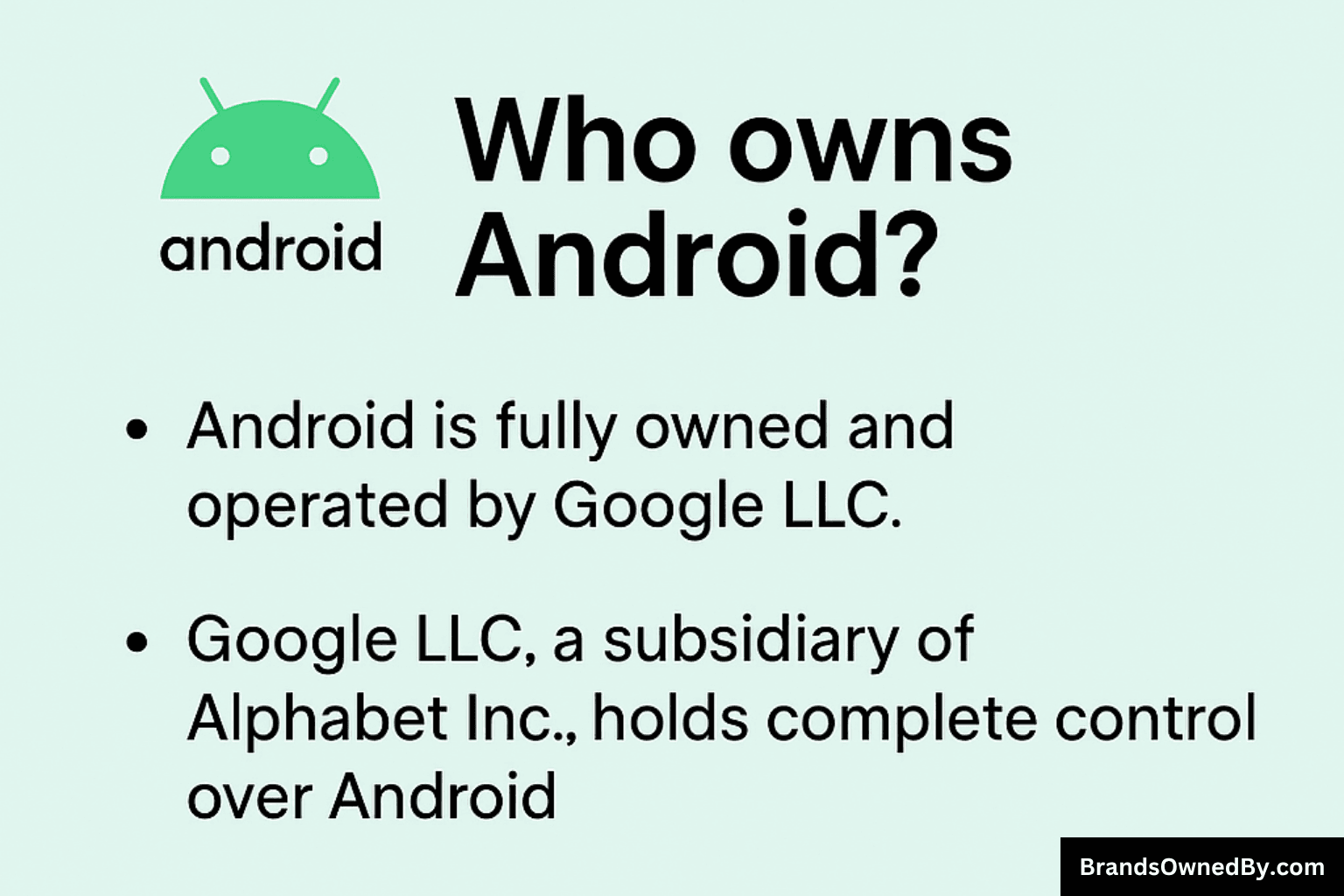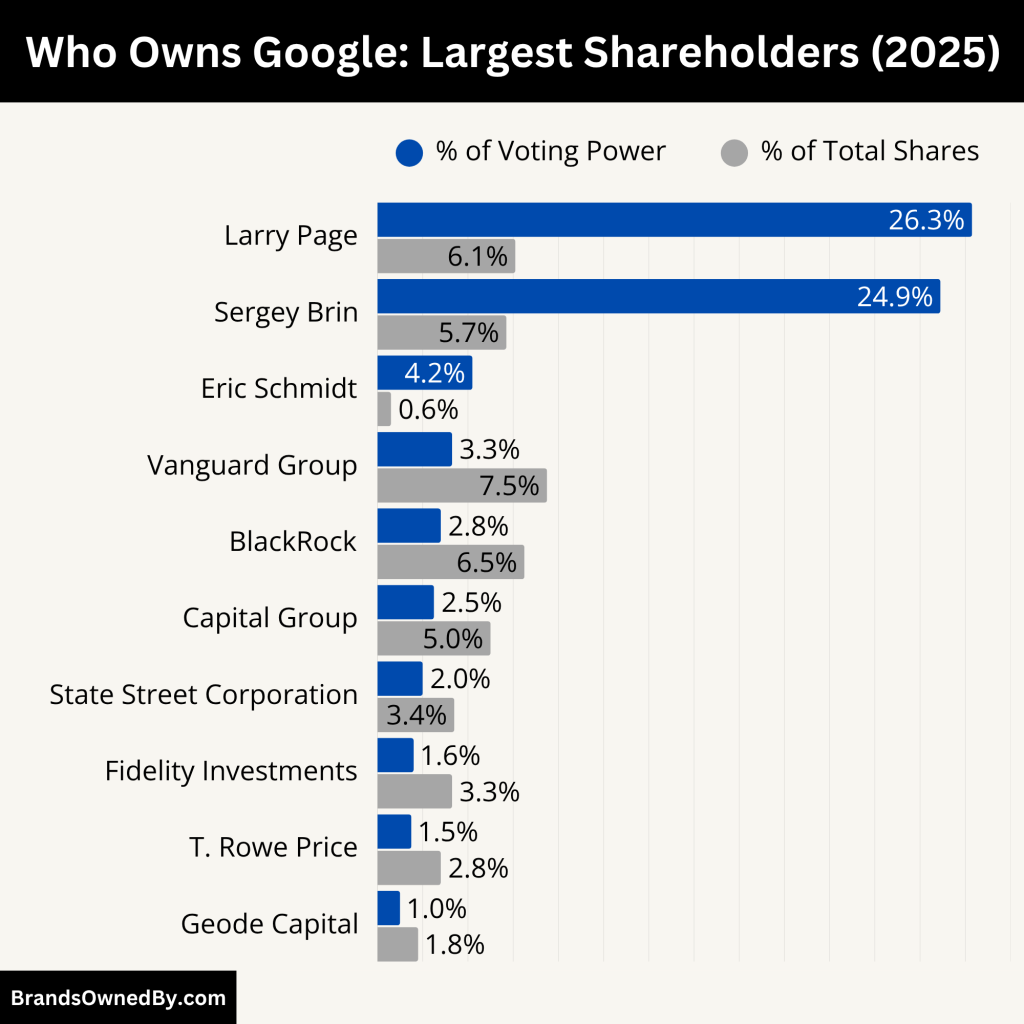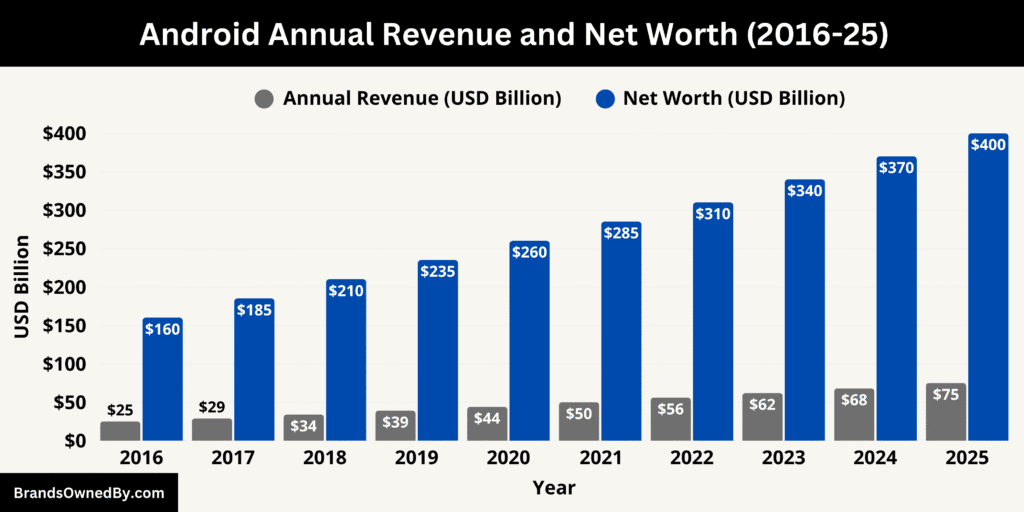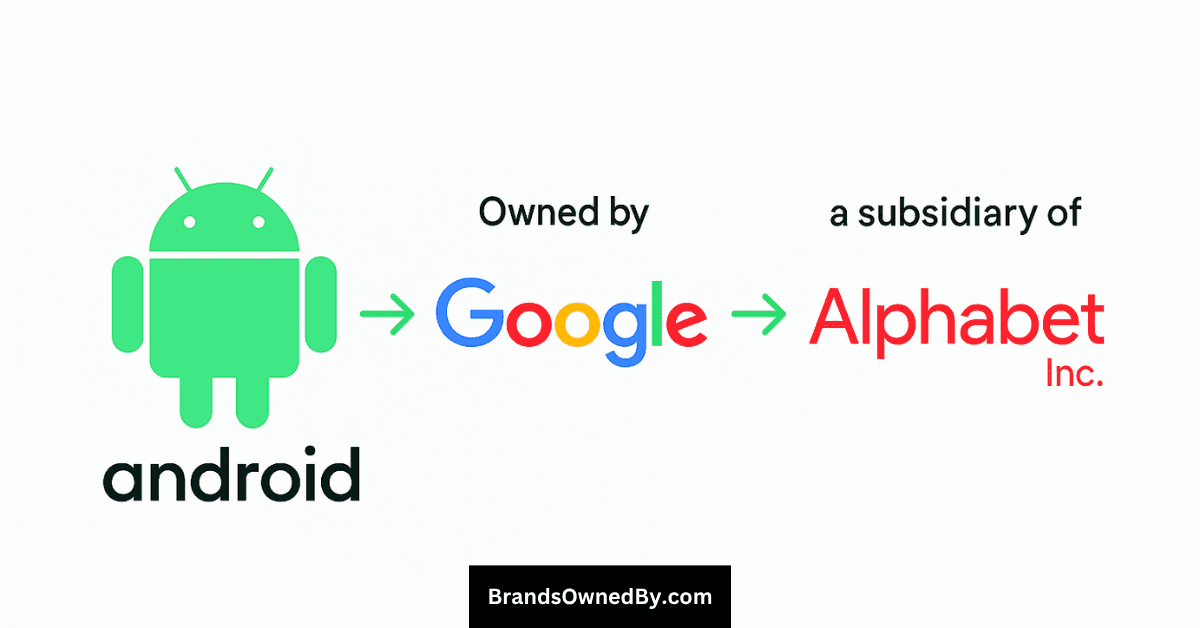Android is the backbone of modern mobile technology, powering billions of smartphones and smart devices around the world. When people ask who owns Android, the answer leads directly to Google. Although Android began as an independent startup, it has grown under Google’s ownership into a vast, open-source platform that defines how much of the world connects and communicates today.
Key Takeaways

- Android is fully owned and operated by Google LLC, which acquired Android Inc. in 2005 and has since developed it into the world’s leading mobile operating system.
- Google LLC, a subsidiary of Alphabet Inc., holds complete control over Android’s development, branding, licensing, and ecosystem management—while maintaining an open-source foundation through the Android Open Source Project (AOSP).
- No individual directly owns Android; however, Alphabet’s largest shareholders—Larry Page, Sergey Brin, The Vanguard Group, and BlackRock—indirectly hold ownership stakes in Android through their holdings in Alphabet.
- Google retains exclusive rights to Android’s trademark and proprietary services, including Google Play, Play Services, and certification programs, making it both an open and commercially controlled platform.
Android Overview
The Android operating system is a software platform that runs on billions of mobile phones and smart devices worldwide. It began as a modest startup project and has evolved into the dominant mobile operating system globally. While the core of Android is open-source, its branding, ecosystem and strategic direction are managed by its parent company. The software supports a vast range of devices from smartphones and tablets to wearables, TVs and cars.
As of 2025, Android continues to receive major releases, with the latest version, Android 16, launched in June.
Android’s flexibility allows manufacturers to customize the system while still tapping into its huge app ecosystem. Its global reach and continuous evolution have made it a central piece of modern computing.
Founders
Android was founded in October 2003 in Palo Alto, California, by Andy Rubin, Rich Miner, Nick Sears, and Chris White.
- Andy Rubin – A veteran software engineer known for his work at Danger Inc., Rubin envisioned Android as an open and intelligent platform for mobile devices.
- Rich Miner – Previously co-founder of Wildfire Communications, Miner brought telecom expertise and later became a venture partner at Google Ventures.
- Nick Sears – Former VP at T-Mobile, Sears contributed valuable carrier and mobile business experience to the project.
- Chris White – A design and user-interface specialist who had worked at WebTV, helping shape Android’s early visual and functional design.
Initially, the team aimed to build software for digital cameras. However, they soon realized smartphones would be the next frontier. The startup’s early mission—to create a more open, flexible, and affordable mobile OS—attracted Google’s attention. In July 2005, Google acquired Android Inc. for around $50 million, keeping the team intact and giving Rubin’s vision global scale.
Today, Android operates as a core division of Google, under the supervision of Hiroshi Lockheimer, Google’s Senior Vice President of Platforms & Ecosystems.
Major Milestones
- 2003 – Android Inc. founded in Palo Alto, California.
- 2005 – Google acquires Android Inc. and begins internal development of a new mobile platform.
- 2007 – Google unveils the Open Handset Alliance, a consortium of tech and telecom companies supporting Android’s development.
- 2008 – Launch of the first commercial Android smartphone: HTC Dream (T-Mobile G1).
- 2010 – Introduction of the Nexus One, Google’s first branded Android phone, marking a new phase of direct hardware collaboration.
- 2011 – Android 3.0 Honeycomb released, optimized for tablets. In the same year, Android surpasses Symbian as the world’s leading smartphone OS.
- 2012 – Google Now introduced, integrating voice-based search and predictive AI into Android.
- 2013 – Android reaches one billion device activations globally.
- 2014 – Launch of Android 5.0 Lollipop, introducing Material Design and a unified visual language across Google services.
- 2015 – Android becomes part of Google’s new holding company structure under Alphabet Inc.
- 2016 – Release of Android 7.0 Nougat, adding split-screen multitasking and improved notifications.
- 2017 – Launch of Android Oreo with Project Treble for faster updates, and Android Go for low-end devices.
- 2018 – Android marks ten years since its commercial debut, with over two billion monthly active devices.
- 2019 – The dessert naming convention ends with Android 10, focusing on simplicity and branding consistency.
- 2020 – Android 11 introduces new privacy and permission controls.
- 2021 – Android 12 debuts with a major visual redesign called Material You, emphasizing customization.
- 2022 – Android 13 enhances user privacy, multilingual support, and cross-device connectivity.
- 2023 – Android 14 focuses on longer battery life, performance optimization, and better foldable device support.
- 2024 – Android 15 integrates AI-driven contextual responses and new generative features through Google’s Gemini models.
- 2025 – Android 16 is launched, pushing forward adaptive intelligence, improved security, and tighter integration with wearables and connected ecosystems.
Who Owns Android in 2025?
![Who Owns Android [Parent Company]](https://brandsownedby.com/wp-content/uploads/2025/10/Who-Owns-Android-Parent-Company-1-1024x1024.png)
Android is owned and managed by Google LLC, which is itself a subsidiary of Alphabet Inc. Although Android began as an independent startup, it became a Google product after being acquired in 2005. Today, Google holds full control over Android’s development, branding, and distribution.
Android’s open-source framework is available to the public under the Android Open Source Project (AOSP), but its trademark, logos, certification process, and proprietary services are controlled exclusively by Google. This dual structure—open software with proprietary components—allows Google to balance community-driven innovation with brand consistency and security standards.
Here’s a quick summary of Android ownership:
- Owner: Google LLC
- Parent Company: Alphabet Inc.
- Acquired: July 2005
- Original Developers: Android Inc. (Andy Rubin, Rich Miner, Nick Sears, Chris White)
- Type: Open-source operating system with proprietary layers (Google Play Services and GMS)
- Control: Managed by Google’s Platforms & Ecosystems division under Hiroshi Lockheimer
- Headquarters: Mountain View, California, USA.
Parent Company: Google LLC

Google is the primary company responsible for Android’s ongoing development. Founded in 1998 by Larry Page and Sergey Brin, Google became a global leader in technology through its search engine, digital advertising, and software ecosystems. Android sits at the heart of Google’s mobile strategy, connecting users to Google’s services and ad ecosystem.
In 2015, Google reorganized under a new corporate umbrella called Alphabet Inc. to separate its experimental ventures from core products like Android, YouTube, and Google Search.
Under this structure, Android remains part of Google’s main operations rather than an independent entity. All decisions related to Android’s development, updates, and partnerships are made within Google’s internal product teams, led by Hiroshi Lockheimer, Google’s Senior Vice President of Platforms & Ecosystems.
Acquisition by Google
In July 2005, Google acquired Android Inc., a small but promising startup founded by Andy Rubin, Rich Miner, Nick Sears, and Chris White. The deal reportedly cost around $50 million and included Android’s employees and intellectual property.
At the time of acquisition, Android was not yet a mobile phone platform—it was initially aimed at digital cameras. After joining Google, the founders pivoted toward building a full-fledged operating system for mobile devices to rival existing platforms like Symbian and Windows Mobile. This strategic shift proved transformative.
Under Google, Android was redesigned as an open platform that would be free for manufacturers to use. This model disrupted the mobile industry, as device makers could adopt Android without paying licensing fees. By combining openness with Google’s growing suite of mobile apps—like Gmail, Maps, and YouTube—Android rapidly became the preferred operating system for global smartphone manufacturers.
Post-Acquisition Development and Control
After the acquisition, Google established a dedicated Android team, led by Andy Rubin, to develop and refine the operating system. The first public version was released in 2008 alongside the HTC Dream (T-Mobile G1), marking Android’s official debut.
Over time, Google layered its proprietary services over the open-source Android foundation. This included the Google Play Store, Play Services, and Google Mobile Services (GMS), which became essential for app functionality and updates. While manufacturers can technically use Android without Google’s services (as in the case of Amazon’s Fire OS), most choose to license Google’s version for access to its app ecosystem.
Today, Android’s ownership structure reflects a balance of open innovation and centralized control. Google manages the main operating system, oversees certification for device manufacturers, and drives updates and security patches. Meanwhile, developers and manufacturers around the world contribute to the open-source portion of Android through AOSP.
Control and Strategic Direction
Though Android operates across thousands of devices and brands, Google maintains full strategic control. It sets the technical standards, defines update schedules, and manages key partnerships. The company also dictates how Android interacts with other Google services like Chrome, Google Assistant, and YouTube.
The ecosystem’s design ensures that while Android remains open to modification, Google’s proprietary components and APIs anchor users within its broader digital environment. This combination of openness and brand control is a major factor behind Android’s long-term dominance.
Android Leadership
The leadership of Android is a key part of its continued success and global dominance. While Android itself is not a standalone company, it operates as a major division within Google LLC, overseen by a specialized leadership structure that ensures innovation, stability, and strategic alignment with Google’s broader ecosystem.
Overall Leadership at Google
Android falls under the leadership of Sundar Pichai, the Chief Executive Officer (CEO) of Google and Alphabet Inc. Since becoming CEO of Google in 2015 and Alphabet in 2019, Pichai has prioritized Android’s growth alongside Chrome, Google Cloud, and artificial intelligence initiatives. His leadership emphasizes user experience, data security, and AI integration across all Google platforms, including Android.
Under Pichai’s direction, Android has evolved from a mobile platform into a connected ecosystem spanning smartphones, TVs, cars, and wearable devices. His vision of “ambient computing”—technology working seamlessly across devices—has guided Android’s recent innovations such as cross-device connectivity, adaptive AI, and integration with Google Assistant.
Head of Android: Hiroshi Lockheimer
The day-to-day operations and development of Android are led by Hiroshi Lockheimer, Senior Vice President of Platforms & Ecosystems at Google. He oversees Android, Chrome, ChromeOS, Play, and Wear OS, ensuring they operate in harmony as part of Google’s broader ecosystem.
Lockheimer joined Google in 2006, just a year after the Android acquisition, and has been deeply involved since its earliest stages. His leadership has focused on improving Android’s user experience, strengthening developer relations, and maintaining Android’s open-source principles while ensuring quality and compatibility across thousands of devices.
He also supervises partnerships with manufacturers, carriers, and developers, balancing Android’s open nature with Google’s proprietary interests, such as Google Play Services and app certifications.
Key Executives Behind Android’s Development
Several key executives and engineering leaders within Google play important roles in Android’s continued success:
- Sameer Samat – Vice President of Android Ecosystem
Samat manages Android’s product direction, partnerships, and long-term ecosystem growth. He focuses on collaboration with global smartphone makers and supports the Android Developer community to ensure software innovation remains strong. - Dave Burke – Vice President of Engineering for Android
Burke oversees the engineering and technical aspects of Android development. His team leads the design and release of new Android versions, system frameworks, and developer tools. He also presents new Android features at Google I/O events each year. - Jeanine Banks – Vice President & General Manager, Developer X
Banks leads the developer relations and experience arm of Google, which includes supporting Android developers through SDK tools, APIs, and Google Play initiatives.
Together, these leaders form the core team driving Android’s innovation, updates, and ecosystem growth. Their combined expertise ensures Android remains adaptable and forward-looking in a rapidly changing tech landscape.
Past Leaders Who Shaped Android
Android’s early development was guided by Andy Rubin, one of its co-founders and the first head of the Android division after Google’s acquisition. Rubin was often referred to as the “father of Android” for his pioneering work in building the system’s foundation and vision of an open mobile platform.
After Rubin’s departure in 2013, Sundar Pichai took over leadership of the Android division. Under his leadership, Android expanded globally and integrated more closely with other Google products like Chrome and Google Play.
When Pichai became CEO of Google, Hiroshi Lockheimer succeeded him in managing Android, continuing to evolve it into a unified ecosystem across devices and services.
Leadership Structure and Decision-Making
Android’s leadership operates through a cross-functional structure at Google. Engineering, product management, design, and ecosystem development teams collaborate across different geographic regions to maintain the platform’s stability and innovation pace.
Decisions related to Android’s direction—such as version features, hardware partnerships, and ecosystem policies—are made through coordinated leadership between the Android division and Google’s senior executive team. This ensures that Android’s strategy aligns with Google’s long-term goals, including cloud integration, AI expansion, and sustainability initiatives.
Leadership Vision
The current Android leadership envisions a future where technology blends seamlessly into everyday life. Their focus areas include:
- Making Android devices work together effortlessly across form factors.
- Advancing AI-driven personalization and automation.
- Strengthening privacy, security, and user control.
- Supporting global developers to innovate within the Android ecosystem.
This vision reflects a balance between openness and strategic direction—keeping Android a platform for everyone, while ensuring consistency and reliability under Google’s stewardship.
Android Annual Revenue and Net Worth

As of October 2025, Android’s ecosystem generates over $70 billion in annual revenue and holds an estimated value exceeding $400 billion. More than an operating system, it represents a global digital infrastructure—powering devices, businesses, and innovations that connect billions of people every day.
Android Revenue Overview
As of 2025, Android’s estimated annual ecosystem revenue stands between $70 billion and $80 billion. The largest contributor is the Google Play Store, which generates more than $60 billion each year from app downloads, subscriptions, and digital transactions.
Advertising through Android devices adds another major revenue stream. Every Android-powered phone and tablet serves as a channel for Google’s ad network—delivering revenue through mobile search, in-app ads, YouTube integration, and promotional placements across millions of apps.
Licensing fees also play a key role. Device manufacturers such as Samsung, Motorola, and Xiaomi pay for access to Google’s proprietary services, including the Play Store, Maps, Gmail, and YouTube, which come bundled with certified Android devices.
Beyond smartphones, Android drives revenue across multiple categories—smart TVs, wearables, infotainment systems, and Internet of Things devices—all of which rely on the Android platform for software functionality. Together, these sources make Android one of the most profitable and influential software ecosystems in existence.
Android’s Net Worth
Although Android does not have a defined corporate balance sheet, its estimated platform value is considered to exceed $400 billion. This figure reflects not just direct revenue, but also the broader economic and technological impact of the Android ecosystem.
Android powers over 3 billion active devices globally, making it the single most-used operating system in the world. Its ecosystem includes millions of developers who build apps and digital products, collectively contributing tens of billions in additional revenue each year.
The platform’s value also lies in its deep integration with Google’s advertising, data, and cloud services. Android’s widespread adoption ensures Google’s continued dominance in mobile advertising and app-based monetization, making it a cornerstone of Google’s business model and a key driver of its long-term growth.
Economic Importance of Android
Android’s influence extends well beyond Google’s internal operations. It fuels a massive global ecosystem of smartphone makers, software developers, accessory manufacturers, and app-based businesses. The open-source nature of Android allows regional and international companies to build their own devices and interfaces, supporting innovation and competition across markets.
From developing nations where Android drives affordable smartphone access to advanced markets focused on AI and foldable devices, the platform is integral to modern digital life. Its yearly updates and expanding hardware compatibility continue to stimulate industries and economies worldwide.
Analysis of Android’s Financial Growth
Over the last decade, Android’s ecosystem has more than tripled in annual revenue and more than doubled in total estimated platform value. The primary contributors to this growth include expansion into new device categories, rising app store income, and the ever-growing base of Android-powered smartphones.
Between 2016 and 2025, Android has maintained consistent growth due to three key factors:
- Global adoption – Android dominates emerging markets and remains the top OS in over 190 countries.
- App ecosystem expansion – Millions of developers contribute to a thriving Play Store economy.
- Hardware diversification – Android powers not only phones but also TVs, wearables, smart displays, and cars.
Android’s financial strength is not measured solely in direct profit—it lies in its ecosystem’s reach, innovation potential, and the billions of devices that rely on it. Together, these factors have made Android one of the most valuable software platforms in modern history.
Brands Owned by Android
As of 2025, Android’s reach extends far beyond smartphones, spanning wearables, automotive systems, smart homes, and entertainment devices. Below is a list of brands and divisions owned by Android as of 2025:
| Name / Brand | Type / Category | Primary Function or Focus | Launch Year | Key Highlights (as of 2025) |
|---|---|---|---|---|
| Google Play | Digital Distribution Platform | Official app store for Android devices; includes Play Store, Play Games, Play Books, Play Movies & TV, and Play Pass | 2012 | Over 3 million apps available; generates more than $60 billion annually through app sales, subscriptions, and advertising. |
| Android Auto | Automotive Software | Smartphone-to-car integration allowing navigation, calls, and media via voice or touchscreen | 2015 | Expanded into Android Automotive OS for native in-car systems; adopted by major automakers like Volvo and Polestar. |
| Android TV / Google TV | Smart TV Platform | Operating system for smart TVs and streaming devices; integrates multiple streaming services | 2014 / 2020 | Powers smart TVs from Sony, TCL, Hisense, and others; unified interface using AI-driven recommendations. |
| Wear OS | Wearable Operating System | Operating system for smartwatches and wearables | 2014 | Powers smartwatches from Samsung, Fossil, and Mobvoi; features deep fitness, health, and Google Assistant integration. |
| Android Open Source Project (AOSP) | Open-Source Software Framework | Provides free, open-source codebase for Android OS | 2007 | Backbone of Android; enables global manufacturers and developers to build customized Android versions. |
| Android One | Mobile Software Program | Offers standardized, secure, and fast Android experience for mid-range and entry-level phones | 2014 | Devices receive direct Google updates for at least two years; targets emerging markets for affordability and reliability. |
| Android Go Edition | Lightweight OS Version | Optimized Android version for low-end smartphones with limited RAM and processing power | 2017 | Powers hundreds of millions of budget smartphones globally; includes lighter versions of Google apps. |
| Google Play Services | Core System Layer | Provides essential APIs, authentication, and background services for Android apps | 2012 | Ensures app compatibility and smooth updates across devices; includes Play Protect, push notifications, and Maps APIs. |
| Android Developers / Jetpack | Developer Tools & Framework | Provides SDKs, APIs, documentation, and Jetpack libraries for app creation | 2008 | Over 6 million active developers; features modern app-building tools like Android Studio and Compose UI. |
| Android Partner Program | Certification & Partnership Network | Certifies hardware partners and ensures device compatibility with Android standards | 2007 | Includes manufacturers like Samsung, Xiaomi, Oppo, and OnePlus; ensures compliance with Google’s compatibility standards. |
| Android Enterprise | Business & Security Platform | Mobile device management (MDM) and work profile solutions for enterprise users | 2018 | Used by corporations and government organizations worldwide; enhances security, data management, and app control. |
| Android Accessibility Suite | Accessibility Tools | Set of tools to assist users with disabilities (e.g., TalkBack, Voice Access, Switch Access) | 2015 | Expands Android’s inclusivity; integrates accessibility features system-wide for better usability across all devices. |
Google Play
The Google Play ecosystem is one of Android’s most important and profitable assets. Launched in 2012 as a unified digital storefront, it combines the Play Store, Play Games, Play Books, Play Movies & TV, and Play Pass under one ecosystem. Through the Play Store, Android users access over three million applications, games, and digital services. Developers worldwide publish their apps through Play Console, enabling Android to maintain its dominant position as the largest app distribution platform globally.
Google Play also serves as a core revenue engine for Android, driving income through app purchases, in-app subscriptions, and advertising integration. The platform’s advanced content recommendation systems, security checks via Play Protect, and AI-powered discovery tools ensure a safe and user-friendly experience for billions of users.
Android Auto
Android Auto is Android’s dedicated software for in-car connectivity. It allows users to mirror and control apps from their Android devices directly through a car’s infotainment system. The platform supports navigation, calls, messages, and music streaming through voice commands powered by Google Assistant.
As of 2025, Android Auto has expanded into native in-car operating systems known as Android Automotive OS, which powers vehicles from manufacturers such as Volvo, Polestar, and Renault. This built-in version doesn’t require a phone connection and provides an integrated automotive experience. Android Auto and Automotive OS are key components of Android’s strategy to dominate connected mobility and smart vehicle ecosystems.
Android TV and Google TV
Android TV, launched in 2014, and its successor Google TV, serve as Android’s entertainment and smart home platforms. Both are built on the Android operating system but tailored for large-screen experiences. Android TV powers smart televisions, streaming boxes, and media sticks across dozens of global brands.
Google TV, which succeeded Android TV in 2020, offers a redesigned interface that unifies streaming platforms such as Netflix, YouTube, and Disney+ under a single, AI-driven recommendation system. It also integrates seamlessly with Google Assistant and the user’s broader Android ecosystem. Together, Android TV and Google TV represent Android’s dominance in home entertainment, enabling billions of hours of streaming each year.
Wear OS
Wear OS is Android’s operating system designed for smartwatches and wearable devices. Originally introduced as Android Wear in 2014 and rebranded as Wear OS in 2018, it has undergone major transformations.
As of 2025, Wear OS is the backbone for leading smartwatches from companies such as Samsung, Fossil, and Mobvoi.
Recent versions of Wear OS integrate tightly with Android smartphones, offering features like health tracking, contactless payments through Google Wallet, voice control, and app synchronization. The operating system leverages AI to provide proactive assistance, fitness insights, and cross-device connectivity. Wear OS has positioned Android as a strong competitor in the wearable technology sector, blending software flexibility with extensive hardware partnerships.
Android Open Source Project (AOSP)
The Android Open Source Project (AOSP) forms the foundation of the Android ecosystem. It provides the base code for all Android devices, freely available for manufacturers, developers, and researchers. AOSP allows companies to customize the operating system for specific needs while maintaining compatibility with the Android framework.
AOSP is one of the most influential open-source initiatives in the world. It powers not only smartphones but also tablets, set-top boxes, and even specialized devices in education, healthcare, and industry. The project is managed by Android’s internal engineering teams and supported by the Open Handset Alliance, a coalition of technology companies that collaborate on Android’s continuous improvement.
Android One
Android One was introduced in 2014 as a program to provide affordable smartphones with a clean, standardized version of Android. While its prominence has fluctuated, Android One remains active in several regions, particularly in Asia, Africa, and Latin America. Devices under the Android One program receive timely software and security updates directly from Google, ensuring consistent performance and reliability.
As of 2025, Android One serves as a strategic initiative for markets where cost-sensitive consumers need dependable smartphones with guaranteed software support. It also plays a role in maintaining brand trust for Android across diverse global markets.
Android Go Edition
Android Go is a streamlined version of the operating system designed for low-end and entry-level smartphones. Launched in 2017, it is optimized for devices with limited memory and processing power, ensuring fast performance even with minimal resources.
Android Go includes lightweight versions of essential Google apps such as Gmail Go, Maps Go, and YouTube Go. As of 2025, it powers hundreds of millions of budget smartphones across developing nations, making Android’s ecosystem accessible to nearly every income group. This edition exemplifies Android’s goal of universal accessibility and digital inclusion.
Google Play Services
Google Play Services is a core software layer embedded within nearly every Android device certified by Google. It serves as a bridge between Android’s open-source base and Google’s proprietary ecosystem. Play Services provides essential background functions—such as app updates, authentication, data synchronization, location services, and API integration—that allow apps to run smoothly across devices.
As of 2025, Play Services continues to be one of Android’s most important operational components, ensuring a consistent user experience regardless of hardware or brand. It also enables critical services like Google Play Protect, push notifications, and AI-driven personalization features.
Android Developers and Jetpack
Android Developers is Android’s official developer ecosystem, providing resources, SDKs, tools, and documentation for app creation. Under this umbrella sits Android Jetpack, a suite of software libraries and components that simplify app development and enhance performance.
As of 2025, the Android developer community exceeds 6 million active developers worldwide, making it one of the largest software ecosystems ever built. Jetpack, along with Android Studio, Compose UI, and Kotlin integration, enables developers to build more efficient, secure, and visually appealing apps. This strong developer foundation remains the backbone of Android’s continued innovation.
Android Partner Program
The Android Partner Program manages collaborations with global smartphone manufacturers, carriers, and hardware providers. It ensures compatibility, certification, and branding consistency across the vast network of Android-powered devices.
Partners participating in this program must meet Google’s software and hardware standards, including compliance with Android Compatibility Definition Documents (CDD). This ensures that devices labeled “Powered by Android” deliver a unified and reliable user experience worldwide.
Android Enterprise
Android Enterprise provides mobile device management (MDM) tools and solutions for businesses. It allows organizations to deploy, manage, and secure Android devices across their workforce. With features like work profiles, data encryption, and app management, Android Enterprise has become a trusted platform for corporate mobility.
As of 2025, it is widely adopted by governments, educational institutions, and global corporations, solidifying Android’s role in professional and business environments.
Android Accessibility Suite
The Android Accessibility Suite is a collection of tools and services that make Android devices more inclusive. It includes TalkBack (screen reader), Voice Access, and Switch Access, designed to help users with visual, hearing, or physical impairments navigate Android more effectively.
This suite underscores Android’s commitment to universal design and digital inclusion—ensuring that technology is accessible to everyone regardless of ability or background.
Final Words
In simple terms, Google owns Android. What began as a small startup idea has become the heart of a global digital ecosystem. Android remains open for developers and manufacturers, but Google guides its evolution, ensuring consistency, innovation, and accessibility across millions of devices. The partnership between openness and control is what keeps Android the world’s leading mobile operating system—continually growing, adapting, and connecting people everywhere.
FAQs
Who made Android?
Android was made by a small startup company called Android Inc., founded in 2003 in Palo Alto, California. The original development was led by Andy Rubin, along with co-founders Rich Miner, Nick Sears, and Chris White. Their goal was to create a smart, adaptable operating system for mobile devices.
Who created Android?
Andy Rubin is widely recognized as the creator of Android. Often called the “Father of Android,” he and his team built the early prototypes and software concepts that eventually became the foundation of the Android operating system.
Who makes the Android operating system?
The Android operating system is made and maintained by Google LLC. After acquiring Android Inc. in 2005, Google took full control of its development. Today, Android is developed under the Android Open Source Project (AOSP), led by Google’s engineering teams, with contributions from global developers and manufacturers.
Who owns the Android company?
The Android company is owned entirely by Google LLC, which is itself a subsidiary of Alphabet Inc. Since the 2005 acquisition, Google has held full ownership and control over Android’s technology, trademarks, and ecosystem.
Who is the real owner of Android?
The real owner of Android is Google LLC. Although the software is open source, Google owns the Android brand, trademark, and proprietary services such as Google Play, Google Mobile Services (GMS), and Google Play Protect.
Is Android owned by Samsung?
No, Android is not owned by Samsung. Samsung is one of the largest manufacturers that use Android on its smartphones and tablets, but it does not own or control the operating system. Samsung customizes Android with its own interface, One UI, but the underlying OS remains owned and developed by Google.
Can Android work without Google?
Yes, Android can technically work without Google, but with limitations. The open-source version of Android, known as AOSP (Android Open Source Project), can be used freely by anyone. However, without Google’s proprietary apps and services—like the Play Store, Maps, and Gmail—the experience becomes limited. Companies like Huawei and Amazon use modified, Google-free versions of Android.
Who is the CEO of Android?
Android does not have a separate CEO because it is a division within Google. The division is led by Hiroshi Lockheimer, Google’s Senior Vice President of Platforms & Ecosystems, who oversees Android, Chrome, and related technologies. The overall leadership comes under Sundar Pichai, the CEO of Google and Alphabet Inc.
Who owned Android before Google?
Before Google acquired it in 2005, Android was owned by Android Inc., an independent startup founded by Andy Rubin, Rich Miner, Nick Sears, and Chris White. The company operated privately for two years before being bought by Google, which then transformed it into the global mobile operating system we know today.

